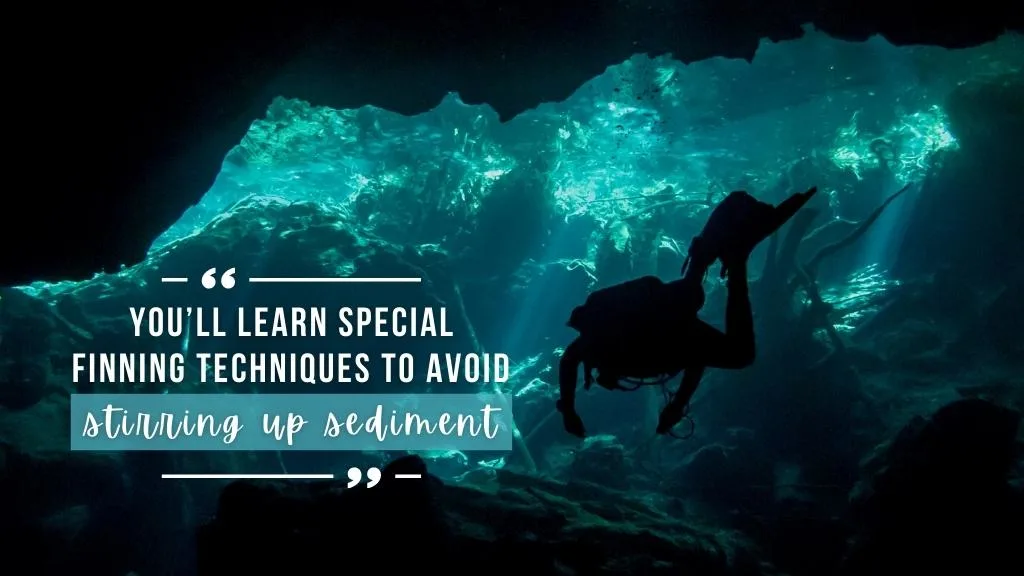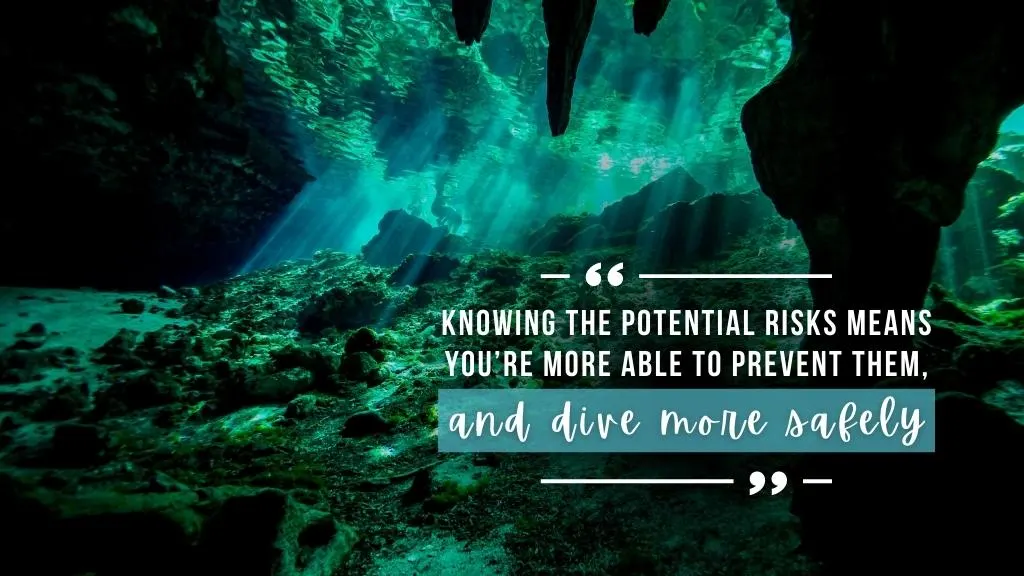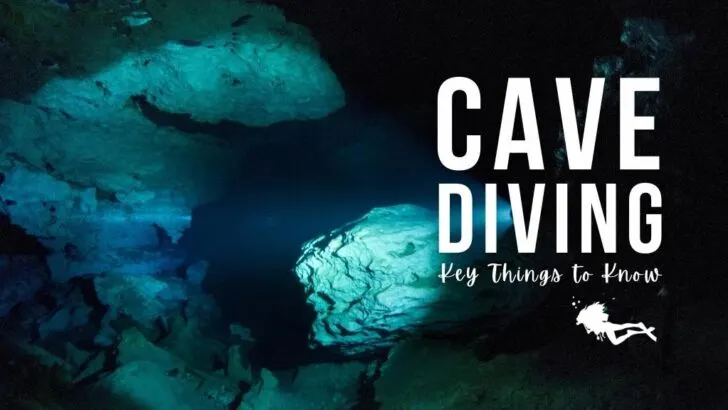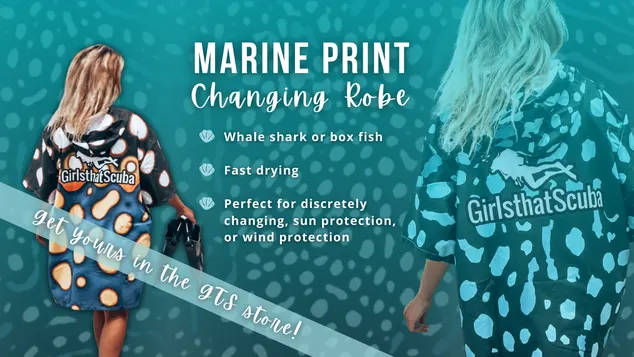Cave diving is a highly technical activity. It combines scuba diving with cave exploration (also known as spelunking). Diving in caves offers the chance to explore the last remaining untouched corners of the world, marvel at ancient rock formations, and even discover new life forms.
The heroic Tham Luang cave rescue of 2018 shone a spotlight on cave diving, sparking a global interest in the activity among divers and non-divers alike. Despite this surge of interest, the cave diving community remains extremely small. Cave diving is typically reserved for scientific research and rescue missions.
However, for some divers, the mystical draw of cave diving is too strong to ignore, and a small number of people take up cave diving as an extreme sport.
Here are some of the key things to know about cave diving. Whether you’re interested in cave diving yourself, want to know how it differs from cavern diving, or are just plain curious, we’ve got you covered.
What is cave diving?
Cave diving, as the name suggests, involves scuba diving in water-filled caves. More specifically, it involves diving in caves with an overhead environment.
Typically, caves are joined via various tunnels, forming an underwater labyrinth that requires excellent navigation skills. The overhead environment prevents vertical access to the surface, blocking natural light and your ability to ascend for air. Cave dives fall under technical diving, as any dive with no immediate access to the surface becomes a technical dive.
This lack of access to the surface also sets cave diving apart from cavern diving. Cavern divers explore no further than 60m (200ft) from the surface. This means the surface typically remains in sight at all times and provides some natural light.
Although cavern diving requires prior training, easy access to the surface makes it far less risky than cave diving. In fact, cavern diving is often classified as recreational diving, with a PADI Cavern Diver Specialist course available for advanced divers. Other recreational agencies may offer similar courses.
In contrast, cave diving is classified as technical diving due to the high risks involved and the level of expertise required to participate.
What experience do I need for cave diving?
Due to the high level of expertise required, it’s estimated that just 1% of scuba divers are fully prepared for safe cave diving.
There are several specialist agencies out there that offer cave diving courses, and the requirements for the course vary between them. Advanced Open Water Diver (or an equivalent certification), combined with a handful of dives (the number varies), is the bare minimum required. You must complete a cave diving course with a trusted instructor to safely explore caves.
Experience is key, and there are heaps of other courses and experiences out there that can help you develop the skills to prepare for safely diving in caves. Consider adding some of the following dive types to your log book before embarking on a cave diving course:
Night Dives
Clocking up some night dive experience is a great idea (and an essential prerequisite for many agencies). You’ll gain confidence in orientating yourself in the darkness, as well as using essential cave-diving tools like torches.

Wreck Dives
You’ll learn special finning techniques to avoid stirring up sediment and learn how to plan dives in overhead environments. You may even get the chance to practice laying and using penetration lines.
Deep Dives
Although cave dives don’t have to be deep, your route may involve some serious descents, and you may swim over some incredibly deep water columns. Practicing deep dives boosts your planning skills and gas management. It teaches you to recognise and manage nitrogen narcosis – something you definitely don’t want to experience for the first time on a cave dive!
Nitrox Dives
Learning to dive with nitrox is an excellent way of extending your bottom time, and this extra time can boost your safety buffer while cave diving.
Trimix Dives
If advanced, technical cave dives are in your future, you may want to work towards training to dive with trimix. Trimix diving reduces the risk of developing gas narcosis and oxygen toxicity at deep depths, which will come in handy if you want to explore some of the deeper caves out there.
Drysuit Dives
Away from the light of the sun, and sometimes in deep locations, things can get pretty cold on a cave dive. If you learnt to dive in the tropics and have barely used a drysuit before, we definitely recommend getting some practice in.
Drysuit diving has more complex buoyancy considerations than wetsuit diving, and you need to make sure your buoyancy is as good as possible before heading into the depths of a cave.
Sidemount Dives
Cave divers need to dive incredibly conservatively to ensure they have enough gas to return to the surface. As part of this, they generally dive with two or more cylinders.
Like other technical diving disciplines, cave divers follow the rule of thirds. One third of the gas is used for the way out, and one third of gas is for the way back. The final third of gas is a reserve in case of emergency.
Although some cave divers dive with back mounted doubles, sidemount is often preferred. Sidemount is more streamlined, offering less risk of damaging the overhead environment. Sidemount divers also have the option of unclipping cylinders and pushing them ahead (a skill known as “gunning”) to manoeuvre through particularly tight tunnels.
Dives, Dives, Dives
Even if the agency you’re going to train with doesn’t require a particularly high number of logged dives for the course, there’s definitely no harm in getting some extra dives in! The more dives you have under your belt, the better.
What equipment do I need for cave diving?
The instructor you’re training with will likely provide you with some, if not all, of the gear you’ll need for cave diving. But you’ll still need to familiarise yourself with it so you can use it confidently.
It’s also nice to invest in a few items of your own (if you can afford it) so that you can get super comfortable with them.
Here are just a few of the items you’ll need to be familiar with for cave diving:
Torches
Note the plural. While divers typically take two dive lights on a night dive (one for back-up), cave divers generally take three torches as a minimum. Diving in caves is all about safety and redundancy – you don’t want to find yourself in total darkness as you’re navigating back to your entry point.
Drysuit
It’s always nice to have your own drysuit so you can get the fit just right – there’s nothing worse than a pesky leak! Learn more about choosing the right drysuit here.
Spools
Guidelines, penetration lines, cave lines, distance lines. These are all names for the same thing – a line wrapped around a spool that divers deploy as they dive. This provides a physical guide back to the entry point. You may also use “cookies” or arrows to mark points of interest or show directions.
Why is cave diving dangerous?
Cave diving is probably the most dangerous form of scuba diving there is. You’re entering deep, dark, tight spaces, and you can end up considerable distances from the surface. What’s more, there’s the potential for falling rocks to hit you, or block an exit.
Water flow can be strong and changeable. You can become entangled in lines, or lose lines entirely. Of course, there’s also always the danger of running out of air. Due to the overhead environment, much smaller complications, like broken torches, can cause panic and develop into a full-blown emergency.

We don’t share these risks to cause fear. Knowing the potential risks means you’re more able to prevent them, and dive more safely as a result.
Plan the Dive, Dive the Plan
Fortunately, the vast majority of incidents can be avoided with proper training and planning. In fact, one UK assessment of cave diving safety states that experience is the main factor in determining cave diver safety.
When it comes to planning a cave dive, there are lots of things to consider. These considerations include equipment, routes, depths, currents, and air supply. Be prepared to make decompression stops as you ascend, use an appropriate gas mixture, and don’t exceed your depth limits. Taking a cave diving course with a thorough instructor will teach you proper dive planning.
Remember that no plans are foolproof. Don’t be afraid to turn back if you start to feel uncomfortable. Finally, follow the rule of thirds and remember to always leave plenty of back-up air left in your cylinder in case you (or a fellow diver) need it.
Where can I go cave diving?
Despite the risks, diving in caves remains a truly unique experience that calls to the inner explorer of some of the world’s hardiest scuba divers. Those who are keen to explore these magical underwater systems are rewarded with a whole new world of dive sites to admire.
Cave diving in Mexico has a world-class reputation thanks to the incredibly clear water of its cenotes (caves). What’s more, the rock formations above and below the water are out of this world. If cave diving sounds a bit too much for you, there are plenty of cavern dives for you to check out too.
Florida cave diving is also up there on most cave divers’ bucket lists. There are extensive underground networks flanked by limestone and filled with fresh spring water just waiting to be explored.
Ultimately, while cave diving certainly isn’t for everyone, it’s easy to see the appeal. It’s also clear why cave divers are held in such high regard. However, for most of us, cavern diving is a more relaxing way to explore underwater caves! Keen to learn more about cave diving? Join us in our Girls that Tech Dive community!

About the Author
Rose has spent the last few years living in Europe, the Seychelles and Kenya, working as a dive instructor, writer and conservationist. She’s back in the UK at the moment and is slowly acclimatising to cooler waters!



